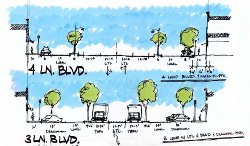Smart Growth Implementation Assistance in Teton County, Idaho
Teton County, Idaho
Source: Pedestrian and Bicycle Information Center (PBIC)
Problem
Rapid growth is threatening the quality of the natural resources and urban fabric of Teton County, Idaho, and posing a hazard to the safety of pedestrians. Towns within the County are updating their comprehensive plans, but lack staff capacity and financial resources to implement smart growth principles that will improve pedestrian safety and livability of the towns.
Background
Teton County, Idaho, is a rural county near the border of Wyoming. Since 1990, the towns of Victor (2006 population of 1,255) and Driggs (2006 population of 1,165) have experienced rapid growth due to the desirability of the region and the proximity of Jackson, Wyoming. As more than 54 percent of Victor workers and 34 percent of Driggs workers work out of state, the county is at risk of becoming a bedroom community to an out-of-state employment center. This poses a distinct threat to the rich natural resources that make the region attractive to development.

Image Source: http://www.epa.gov/smartgrowth/pdf/victordriggs.pdf
The towns are in search of solutions that will redirect growth to the towns' centers in a way that will combat the dramatic growth and provide economic, health, and environmental benefits. The Highway 33 corridor that functions as the main street is used as a trucking route and conditions downtown do not facilitate safe transportation for pedestrians. With limited financial resources, the timing and planning of this development is crucial to improving the walkability and overall pedestrian environments in the downtowns, a goal specified by public outreach throughout the community. The public outreach sessions conducted also identified community concerns related to traffic safety, especially involving children, low rents in downtown due to a lack of pedestrian activity, and concern over the changes in small town character occurring through new development.
Solution
The towns of Victor and Driggs partnered with a local non-profit, Valley Advocates for Responsible Development, to apply for assistance from the Environmental Protection Agency's Smart Growth Implementation Assistance (SGIA) program. The SGIA program provides direct technical assistance to state, local, and tribal governments in the form of policy analysis and public participation. In this case, direct technical assistance carried a $45,000 grant component to assist in the process.
The EPA team conducted in-depth market studies to determine the barriers to creating a successful smart growth strategy and implementing the pedestrian-oriented goals established through public participatory processes. These studies compiled comprehensive economic and demographic profiles of Driggs, Victor, and Teton County; detailed the trends in local retail sales and real estate transactions; and created inventories of developed, undeveloped, and protected lands.
Following these processes, the team conducted a policy review of the existing codes, policies, design guidelines, and regulations. Examining the parking regulations, traffic management systems, and development approval process and comparing them to projected growth, the team aimed to make recommendations that would lower the barriers to redevelopment and infill in order to attract developers. Garnering public support and ensuring the local policies conform to the visions identified in community sessions help make the community "redevelopment ready."
To help build consensus, the Victor planning staff conducted community visioning workshops in which both long-time and new residents of the community were invited to bring a "meaningful food item" and share stories of the area's history. Through these storytelling circles, residents found consistent elements in their vision of the community that helped establish support for returning some of the historic pedestrian elements to the downtown, as well as improvements like back-in parking.
Results
The in-depth review of existing policies, community preferences, barriers to smart growth development, and projections for future growth resulted in a published report of conditions and recommendations for Driggs and Victor. These recommendations, designed to produce "redevelopment ready" communities, centered on five key principles identified through community input and the market reviews. To achieve "readiness" in Teton, the five goals were:
- "Unlocking the Market" by bringing development codes into line with the desired location of future development;
- Enabling Affordable Housing to provide a variety of options for residents;
- Managing Parking;
- Ensuring Connectivity; and
- Supporting cooperation between the local and county governments.

Image Source: http://www.epa.gov/smartgrowth/pdf/victordriggs.pdf
Since a state road, Highway 33, functions as the "Main Street" for both communities, there were concerns over heavy truck traffic, speed, and congestion. To address this, the report specified a number of design alternatives for intersections and street layouts to improve connectivity and safety for non-motorized transportation. Among these alternatives, the team developed schematics and renderings of 3- and 4-lane separated boulevards and center median parkways, as well as recommending strategies for public alley access to off-street parking, parking credits for on-street spaces, diagonal alignments, and other strategies. The team also provided model parking guidelines, traditional neighborhood development guidelines, and small lot zoning guidelines, which all featured prominently in the report's recommended plan. As stated, Victor adopted elements like road diets and back-in parking to improve pedestrian conditions.
Additionally, the report detailed a number of zoning and land use changes that would improve connectivity and better enable future infill development that would not threaten the community character or natural resources of the region. Among these changes were the recommendation of small lot zoning, defined community edges, and other policies that would orient development to the defined goals of the towns. While community input sessions raised concerns over the conversion of retail space to office, rents that were insufficient to justify new projects, and past development that had not "paid for itself," the report recommendations go a long way to making the development market easier for developers to navigate in a way that is consistent with the goals.
Finally, the work done through this program helped to establish the groundwork for pedestrian-focused improvements and leverage substantial investment from other sources, like the Orton Foundation, to complete the redesign of Main Street and future projects such as better facility lighting.
Contact
Matthew Dalbey
EPA Project Manager
202-566-2860
dalbey.matthew@epa.gov
Cari Golden
Planning and Zoning Administrator
City of Victor
208-787-2940
victcitycg@tetontel.com
Doug Self
Planning and Zoning Administrator
City of Driggs
208-354-2362
pzdriggs@pdt.net
Resources
Report: Growing Our Communities
Smart Growth Implementation Assistance Project Summaries
Valley Advocates for Responsible Development




